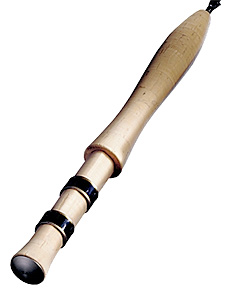
Keeping your fly fishing outfit clean, functional and nice-looking is not a difficult task, nor does it take longer than a few hours a year total. Even though this task is simple, it's one that many of us fly anglers tend to ignore until something actually breaks down.
![]()
 Your fly-fishing outfit can be broken down into three separate components — a fly rod, reel and line — and all three of these components need to be regularly cleaned and maintained.
Your fly-fishing outfit can be broken down into three separate components — a fly rod, reel and line — and all three of these components need to be regularly cleaned and maintained.
How to Clean the Fly Rod
If you have never cleaned a fly rod before, it might seem like quite a bit of work, but if you break it down into a few different sections and do one or two a day you will get through the rod faster than you might think. Cleaning the fly rod can be broken down into a three part process involving the cork grip, the rod blank and the reel seat.
Cleaning the Cork Grip of a Fly Rod
 |
| The cork grip on a fly rod generally is the most laborious job when it comes to cleaning your fly rod, seeing as it takes a beating from the elements. |
The cork grip on a fly rod is generally the most laborious part of the job as it takes a beating from the elements, fish slime and whatever else you seem to set it down on. There are many different types of cleansers on the market today for cleaning the handle on your rod. The best way to really get the grit and grime out of it is with a light sanding.
If you decide to give the rod handle a quick once-over with sandpaper, be careful not to sand the handle to the point of changing the shape of the grip. You want to use a fine-grit sandpaper to remove any debris and grim that has become imbedded in the handle.
After you've taken the soiled layer off of the top of the handle, use a commercial cleaner or a bar of ordinary hand soap to really get your handle looking its best. These cleaners will do a great job of getting out any dark blemishes in the cork, as well as lighten the cork back to its original color. A quick rinsing with warm water will get any excessive cleaner off of the handle, and a few hours drying time will help to show any spots that you might have missed.
Since the handle was sanded lightly, you will need to reapply a waterproofing seal to the cork. These waterproofing products usually need to be applied in two coats with an hour or so drying time in between dressings. When dry, the grip will be clean and look almost new again.
Cleaning the Fly Rod Blank
The rod blank does not need as much cleaning as the rest of the components of the fly rod due to its smooth, epoxy finish. Look for spots of dirt, grime, dried-on algae or water spots, and then clean them with a light solution of soapy water or commercial cleanser.
1. Dry the blank thoroughly from tip-to-butt and see if anything was missed. Pay close attention to the guide feet and if there is any build-up of debris use a Q-tip to dislodge any hard-to-reach dirt. Additionally, when working in and around these guide feet, inspect each carefully for signs of wear and grooving. This grooving, if severe enough, can cause abrasion of the fly line to the point where it fails under the weight of a big fish. After you are satisfied with the rod's cleanliness, you have the choice of whether or not you want to apply a rod polish. Rod polishes are great in giving a nice clean look to the blank while helping to prevent future buildup.
2. After you have cleaned the rod blank, turn your attention to the ferrule section. These ferrules need to be kept clean and well-lubricated so that they go together and come apart easily. Care and maintenance of most ferrules consists of simply keeping them clean and debris-free.
3. With a clean cloth, wipe off the male ferrule, and then use a dry Q-Tip to clean the inside of the female ferrule. If excessive dirt and grime are present then a quick wiping with a commercial cleaner might be needed. If you do use a commercial cleaner or find that the ferrules are sticking slightly, apply a light coat of white candle wax to the surface of the male ferrule.
Cleaning the Fly Reel Seat and Hardware
The reel seat is the last part of the fly rod that needs cleaning, and attention to detail will help this intricate work go smoothly. Many times the reel seat will be filled with sand and mud slowly wearing away the shiny finish associated with these metal parts. A good rinse with warm water and a little scrubbing should dislodge any stubborn dirt from seat spacers or hardware while a small amount of polish will get things shining like new.
The fly rod is normally the most expensive of a fly anglers rig; keeping it clean and in good working order should be a top priority. A few hours of annual care a year and a small amount of regular maintenance will keep your rod looking as if it just left the store's display case.
 |
| A light cleaning and annual maintenance check will ensure all things are in good condition for the upcoming year of new adventures. |
How to Clean Your Fly Reel
The reel is probably the least understood of the different components that make up fly outfit, and for all intents purposes, you really do not want to take out any of the small moving parts. To clean your reel, simply release the spool for the housing and look on the back of the spool to see if there is any dirt that has built up in the gears.
If there is buildup in the gears, take a Q-tip and carefully swab it away. Then check the housing to see if any dirt has gotten onto the spindle or its grease and clean as necessary. If you find yourself removing large amounts of dirty grease, make sure that you reapply a fresh coat before closing up the reel. As far as the outside of the reel is concerned, a solution of soapy water or a commercial cleanser should make things spotless.
Cleaning Your Fly Line
According to most major fly fishing line manufacturers there are many different reasons that fly fisherman should regularly clean their fly line. Some of these reasons are environmental, such as exposure to heat or fishing in dirty/stained water. Others reasons are human-induced such as exposure to solvents found in insect repellents or sun screen. The bottom line is that if you consider all of these factors together they could severely hamper the performance and lifespan of your fly line. A properly cleaned line will reduce the amount of friction in the guides, decrease tangling and improve floatation on the water.
 |
| Fly Fishing Line Dressing and Cleaning Kit is compact easy to carry while fishing, works great on wet or dry fly lines. |
A wide variety of fishing line dressings and cleaners such as the popular Scientific Anglers Fly Fishing Line Dressing Cleaning Kit are available today that make this tedious process go faster with better results. For the most part, these cleaning systems consist of two parts — a slightly abrasive pad and a cleaning solvent to clean the fly-line and a separate dressing to help protect the outer finish of the line.
The actual line cleaning process is quite easy. Simply place a few drops of cleaning solution on the abrasive pad and strip out all of your line through the pad. Then place a few drops of line dressing in the pad and wind the line back in through the dressing.
If you have never cast a dirty line, and then cleaned and dressed your line with one of these conditioners and cast again for comparison, you will not believe the difference in the feel of your line during casting. A few simple minutes is all it takes to get you casting farther and smoother than you ever thought possible with that old line.
If you think about the number of hours you depend on your fly fishing outfit to provide no-nonsense, hassle-free service, it only makes sense that you keep all parts of it in top working order. A light cleaning and annual maintenance check will ensure all things are in good condition for the upcoming year.
- 6854 views

